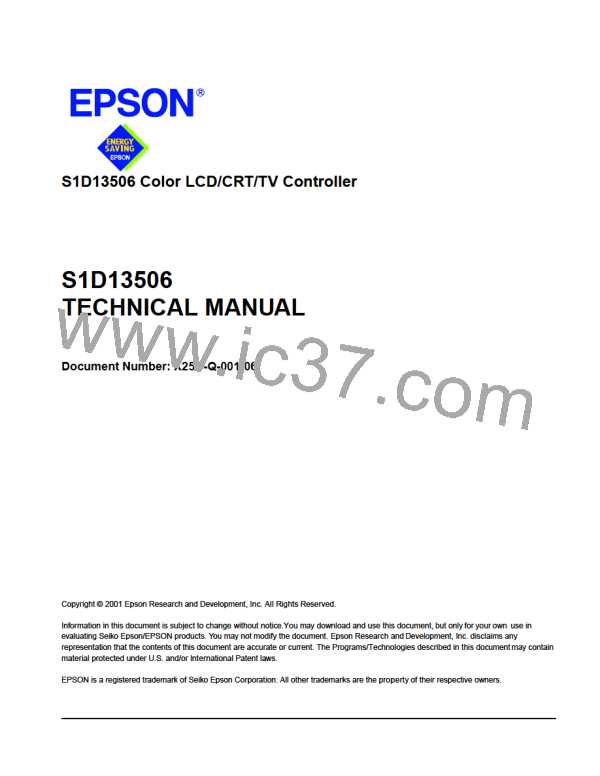Page 128
Epson Research and Development
Vancouver Design Center
14.2.7 Virtual Display
int seVirtInit(DWORD Width, DWORD Height)
int seLcdVirtInit(DWORD Width, DWORD Height)
int seCrtVirtInit(DWORD Width, DWORD Height)
int seTvVirtInit(DWORD Width, DWORD Height)
int seLcdCrtVirtInit(DWORD Width, DWORD Height)
int seLcdTvVirtInit(DWORD Width, DWORD Height)
Description:
These functions prepare the S1D13506 for displaying a virtual image.
“Virtual Image” describes the condition where the image contained in display memory is
larger than the physical display. In this situation the display surface is used as a window
into the larger display memory area. Panning (right/left) and scrolling (up/down) are used
move the display surface in order to view the entire image a portion at a time.
seVirtInit() prepares the current active surface for virtual image display. Memory is allo-
cated based on width, height and the current color depth.
seLcdVirtInit initializes and allocates memory for the LCD based on width and height and
color depth. If the panel surface is rotated 90 or 270 degrees then the height is limited to a
maximum 1024 lines.
seCrtVirtInit and seTvVirtInit initialize and allocate memory for the given display based
on current width and height and color depth.
seLcdCrtVirtInit and seLcdTvVirtInit initialize and allocate memory for a surface which
combines both LCD and CRT/TV. Memory is allocated based on the requirements of the
larger of the two surfaces (if different). If the panel surface is rotated 90 or 270 degrees
then the height is limited to a maximum of 1024 lines.
Memory previously allocated for this surface is released then reallocated to the larger size.
Parameters:
Width
The desired virtual width of the display in pixels.
Width must be a multiple of the number of pixels contained in one word
of display memory. At 15/16 bit per pixel Width may be any value. At 8
bit per pixel Width must be a multiple of two and at 4 bit per pixel
Width must be a multiple of four.
Height
The desired virtual height of the display in pixels.
The HAL performs internal memory management to ensure that all
display surfaces and cursor/ink layer have sufficient memory for
operation. The Height parameter is required so the HAL can determine
the amount of memory the application requires for the virtual image.
Return Value:
ERR_OK
The function completed successfully.
ERR_HAL_BAD_ARG
The requested virtual dimensions are smaller than
the physical display size.
ERR_NOT_ENOUGH_MEMORY There is insufficient free display memory to set the
requested virtual display size.
S1D13506
X25B-G-003-03
Programming Notes and Examples
Issue Date: 01/02/06

 EPSON [ EPSON COMPANY ]
EPSON [ EPSON COMPANY ]